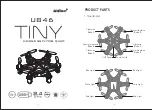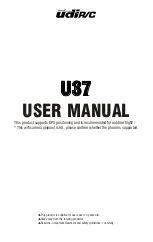
PRISM FLIGHT MANUAL
12
1. PRISM central airframe (houses the flight
controller and C2 Link)
2. Front-facing wide-angle integrated High Definition
FPV camera
3. T-motor U8ii motor (x2 for Coaxial)
4. Collapsible GPS antennas
5. Detaching T-bar landing gear
6. Aircraft power supply input ports
7. Watts Innovations smart propulsion system
attachment assembly and folding pivot
8. Locking hook to anchor boom when folded
9. Communications link antennas
10. Watts Innovations battery trays for 2x 12s or 4x
6S 10,000-16,000 mAh lithium-polymer batteries
11. 12mm rail payload mounting system
12. Spring-loaded release knob for folding propulsion
boom
Table 1: COMPONENT LIST
PRISM was created to be propulsion-system agnostic, meaning it can fly as either a
quadcopter or coaxial x8, with any motor/ESC/propeller. Each propulsion system arm is
user-changeable by removing only two screws. This allows users to change the propulsion
configuration according to their needs. This gives users the freedom to change between
a quadcopter or a coaxial x8, or replace one individual propulsion system in the event that
one is damaged.
Watts Innovations intends to offer various propulsion systems for PRISM. The current
offered propulsion systems are as follows:
• TMotor U8ii in a Quadcopter Configuration with folding FA28” Propellers
• TMotor U8ii in a Coaxial X8 Configuration with folding FA28” Propellers
Each propulsion system consists of a motor, propeller, ESC, carbon fiber tube, and mating
bracket. Each propulsion system is hard-coded to work in only one socket location: Front
Right, Front Left, Back Right or Back Left. Only the Front Right propulsion system can be
inserted into the front right socket, and only the back left to the back left, etc. The user can
verify that the propulsion system is inserted in the correct socket by going to PRISM menu
page in the WattsQGC (See Chapter 7, section 7.11.2, subsection II).
PRISM’s features a patent pending technology which is called Propulsion ID. Propulsion ID
allows the user to insert any type of propulsion system that Watts Innovations produces
into the aircraft, at which time the drone will automatically understand which propulsion
system is connected, and then automatically load in the parameters that are necessary for
flight for that particular propulsion system. In layman’s terms, this allows a user
1.3.3 PROPULSION SYSTEM
Summary of Contents for PRISM R.P.A.S.
Page 3: ...PRISM FLIGHT MANUAL 3 INTENTIONALLY LEFT BLANK...
Page 5: ...PRISM FLIGHT MANUAL 5 INTENTIONALLY LEFT BLANK...
Page 7: ...PRISM FLIGHT MANUAL 7 INTENTIONALLY LEFT BLANK...
Page 18: ...PRISM FLIGHT MANUAL 18 Figures 5 6 PRISM PAYLOAD AND FLIGHT TIME CALCULATIONS...
Page 21: ...PRISM FLIGHT MANUAL 21 Figure 7 RPA ORIENTATION DURING TAKEOFF LANDING...
Page 47: ...PRISM FLIGHT MANUAL 47 Figure 8 PRISM POWER CIRCUIT DIAGRAM...
Page 53: ...PRISM FLIGHT MANUAL 53...
Page 54: ...PRISM FLIGHT MANUAL 54...
Page 57: ...PRISM FLIGHT MANUAL 57 Figure 14 20 WATTSQGC APPLICATION SETTINGS GENERAL...
Page 67: ...PRISM FLIGHT MANUAL 67 Figure 31 COMPASS CALIBRATION SCREEN...
Page 81: ...PRISM FLIGHT MANUAL 81 Figure 46 47 USER SELECTABLE TELEMETRY VALUES FOR HUD...
Page 84: ...PRISM FLIGHT MANUAL 84 Figure 50 51 WATTSQGC PRE FLIGHT CHECKLIST...
Page 103: ...PRISM FLIGHT MANUAL 103 Assembled battery pack Smaller battery assembly Assembled battery pack...
Page 106: ...PRISM FLIGHT MANUAL 106 Battery Packs Top Mounted Battery Packs Bottom Mounted...
Page 136: ...PRISM FLIGHT MANUAL 136 SUPPLEMENT 1...
Page 137: ...PRISM FLIGHT MANUAL 137 SUPPLEMENT 2A...
Page 138: ...PRISM FLIGHT MANUAL 138 SUPPLEMENT 2B...
Page 139: ...PRISM FLIGHT MANUAL 139 SUPPLEMENT 3...













































